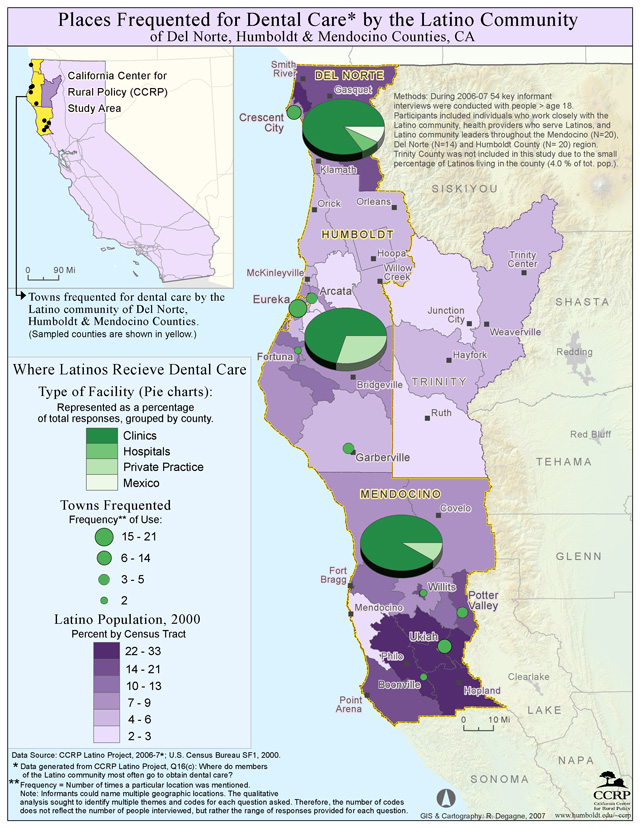
The CCRP report says greater access is essential. It endorses replication of Humboldt County’s Mobile Medical Clinic to take services, including dental treatment, to locations where Latinos purchase food and places where they often congregate, like family gatherings and churches. As one respondent put it, “Transportation is complicated.”
The research indicates that transportation to distant health care facilities is often beyond the means of the region’s Latinos, and high fuel prices deter many of them from seeking care. Time is also a factor. Respondents said transport by car averages 30 to 40 minutes and bus travel can take 60 minutes, plus wait time. A bus passenger with an afternoon appointment at three or four p.m. would have to depart at eight in the morning, absorbing the better part of a day.
The CCRP study mapped Latinos’ Redwood Coast mobility patterns, which will make it easier for traveling clinics to tap into locations heavily frequented by Latinos in need.
That need is acute. Between 1990 and 2000, Humboldt County’s Latino population shot up almost 65 percent. Mendocino and Del Norte Counties saw 72 percent and 59 percent hikes, respectively. Across the region, Latino population jumped nearly 68 percent, a dramatic demographic change that prompted the CCRP’s unprecedented study.
Titled “Rural Latino Project Final Report,” the analysis was funded by the California Endowment and encompasses all three counties. It contains key baseline data on Latino health issues.
Advanced mapping technology was used to display patterns of people and place. The principal investigator was HSU Sociology Professor Sheila Lakshmi Steinberg, director of CCRP’s community research, who was assisted by CCRP student researchers Marian Strong and Nanette Yandell and CCRP interns Adriana Guzman and Dyvonia Burgos.
Redwood Latinos prefer bilingual family clinics and the report underscores the importance of building on existing community networks that comprise a crucial support system in the North Coast region . “These groups and organizations best understand how to communicate with Latinos and have gained their trust,” the report states. “Medical organizations that have not yet effectively integrated Latinos can work with these Latino-oriented community networks and groups to create the most effective and appropriate outreach efforts and services.”
The report underscores that medical providers benefit financially when they are bilingual. Business traffic and patient clientele grow markedly. In the words of the report, “Having staff, providers and doctors who speak Spanish is key to meeting the health needs of the Latino population. Many organizations within the Redwood Coast region have begun to do this, and should be supported to continue these efforts.”
Marina Cortez Hash, outreach enrollment coordinator for Healthy Kids Humboldt, agreed bilingual care is vital. For example, she said, Latino families who approached a local dental clinic for an appointment misunderstood the three-week waiting period to mean the clinic was not scheduling appointments at all. “Therefore, the families would give up,” she said.
Although the Medi-Cal safety net sustains many Latino immigrant families, inadequate insurance coverage is a serious problem. Latino children are at greater risk owing to the shortage, according to the study.
The CCRP suggests Latino groups and networks collaborate with Redwood Coast employers and businesses to address the shortfall. “The more that Latinos can receive health insurance through their employment, the better it is for the population.”
On another front, the study recommends that the region’s news organizations hire Latino staff to beef up coverage of Latino issues, health care in particular. An examination of 63 news articles in Humboldt County showed that only 3.2 percent covered health care. Nearly 60 percent dealt with immigration. Likewise in Mendocino County, scarcely more than four percent of 72 articles centered on health services; 37.5 percent covered immigration, and nearly 28 percent were about crime.
In general, the area’s Latino population suffers from lack of visibility and recognition that it is a substantial contributor to the larger Redwood Coast community, according to the CCRP.